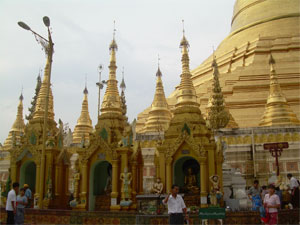Semester at
Sea Fall
2006 Voyage 
- Sarah's Home Page
- My bio!
- The Costly
Implications of Globalization: Beijing & Cairo
- The Pressures of Global China
- The Transnationalization of
Vietnam
- Horizontal
& Vertical Tensions in Myanmar
- India: Discovering Varanasi
- Turkey: Transnational vs
Vernacular in Istanbul
- Contrasts of Modern Day Egypt
- Open Letter
Horizontal and Vertical Tensions
in Myanmar

By Sarah Grimaldi
I stayed in Yangon the entire time
in
As
mentioned in the reading of Donald Seekins, there were examples of the
vertical
versus horizontal power throughout the city. I observed several black
market
stands for money exchanges that our tour guide pointed out to us. As
the state
is trying to reassert vertical power, the attempts of the urban
population to
exercise its horizontal power were evident. The Shwe Dagon Pagoda is a
key
example of monumental Buddhism to acquire legitimacy and deter
resurfacing of
democratic movement and horizontal power. The vernacular,
transnational,
horizontal, and vertical juxtapositions in